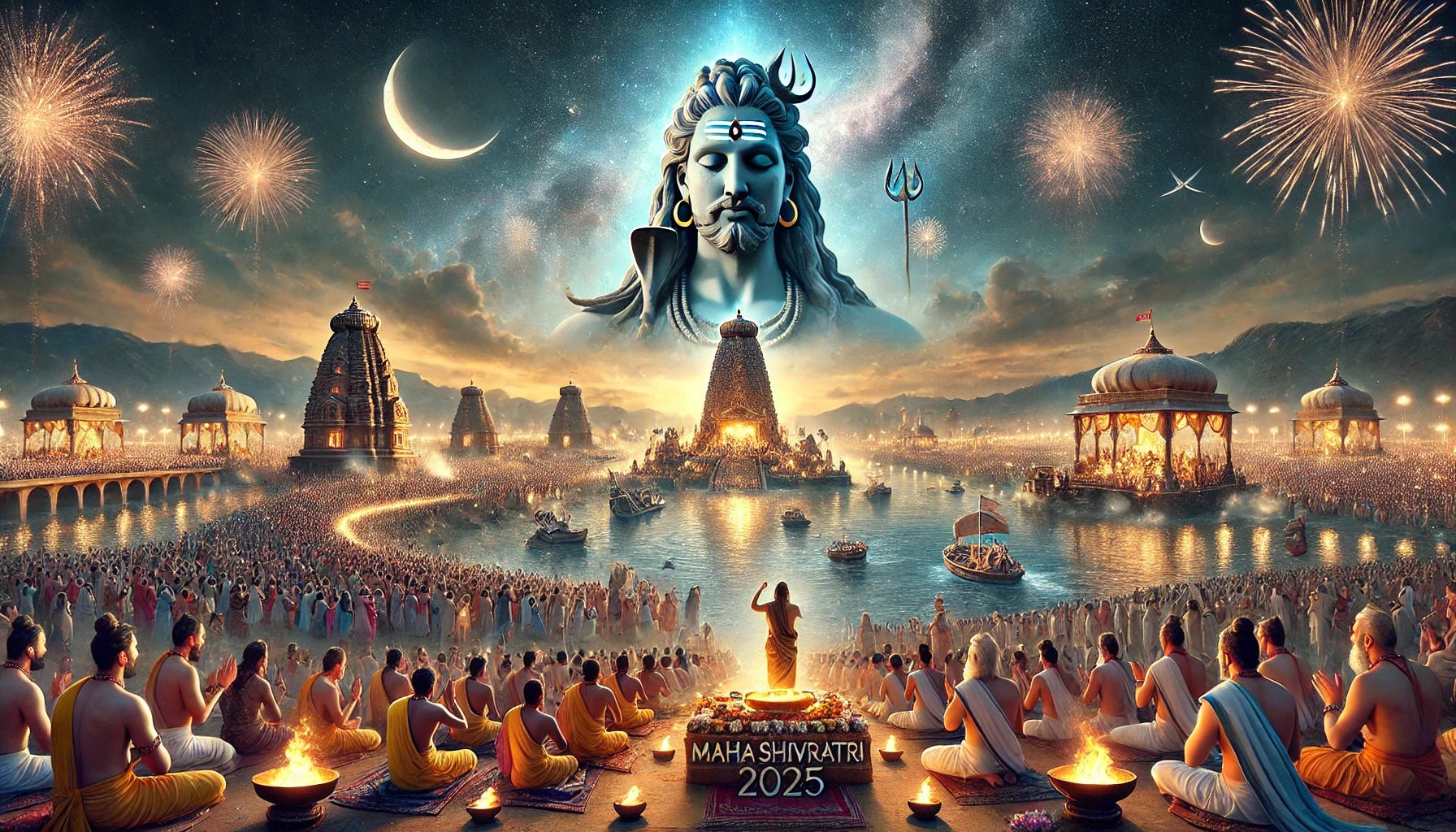Maha Shivratri, one of the most revered Hindu festivals dedicated to Lord Shiva, falls on February 26, 2025. This auspicious occasion holds deep spiritual significance, marking the divine convergence of devotion, rituals, and cosmic energy. What makes Maha Shivratri 2025 even more special is its rare alignment with the Mahakumbh Mela in Prayagraj, an event that occurs once in 12 years. The confluence of these two powerful spiritual events is expected to bring an unparalleled divine experience, attracting millions of devotees, ascetics, and spiritual seekers from across the world.
Historical and Mythological Significance of Maha Shivratri
Maha Shivratri, meaning ‘the great night of Shiva,’ is observed annually on the 14th day of the Krishna Paksha (waning moon) in the month of Phalguna. The festival is associated with multiple legends:
The Celestial Wedding: According to Hindu scriptures, Maha Shivratri marks the divine marriage of Lord Shiva and Goddess Parvati.
The Night of Tandava: It is believed that on this night, Shiva performed the Tandava, the cosmic dance of creation, preservation, and destruction.
The Neelkanth Legend: As per the Samudra Manthan (churning of the ocean), Lord Shiva drank the deadly poison (Halahala) to save the universe, holding it in his throat and earning the title ‘Neelkanth’ (the blue-throated one).
The Linga Manifestation: Another legend states that on Maha Shivratri, Lord Shiva appeared in the form of a Jyotirlinga, a divine column of light, proving his supremacy over Lord Vishnu and Lord Brahma.
Maha Shivratri 2025: Timeline and Rituals
Key Timings for Maha Shivratri 2025:
Nishita Kaal Puja Muhurat: 12:07 AM to 12:57 AM (February 27, 2025)
Shivratri Parana Time: After sunrise on February 27, 2025
Sacred Rituals Observed
Maha Shivratri is observed with deep devotion, penance, and austerity. Some of the key rituals include:
Fasting: Devotees observe a strict fast, consuming only fruits and water or engaging in Nirjala Vrat (waterless fast) to purify the body and mind.
Shiva Linga Abhishek: The Shiva Linga is bathed with sacred substances such as milk, honey, curd, ghee, and Ganga Jal, followed by offerings of Bilva (Bel) leaves, Datura, and white flowers.
Chanting of Mantras: Devotees chant ‘Om Namah Shivaya’, the powerful Panchakshara mantra, and recite the Shiva Chalisa and Maha Mrityunjaya Mantra for spiritual upliftment.
Night-long Vigil (Jagran): Temples remain open all night, and devotees participate in bhajans, kirtans, and storytelling of Shiva Purana.
Meditation and Yoga: Many seek inner peace through meditation and yogic practices, as Maha Shivratri is considered an auspicious time to attain self-realization.
Rudra Abhishek: Special pujas like Rudrabhishek are performed to seek Lord Shiva’s blessings for health, prosperity, and liberation.
Why Maha Shivratri 2025 is Special: The Mahakumbh Connection
The Mahakumbh Mela in 2025 at Prayagraj (Allahabad) is a once-in-12-years grand spiritual gathering, drawing millions of saints, sadhus, devotees, and pilgrims. Maha Shivratri occurring during the Mahakumbh enhances its significance manifold.
The Power of Prayagraj’s Triveni Sangam
Prayagraj, where the rivers Ganga, Yamuna, and the mythical Saraswati merge, becomes the ultimate sacred site during Mahakumbh. On Maha Shivratri, a special Shahi Snan (royal bath) will be observed, where revered saints and Akharas (monastic orders) will lead the holy dip, believed to wash away sins and grant moksha (liberation).
Rare Planetary Alignment and Its Significance
In 2025, planetary alignments are set to amplify the festival’s energy:
Shani (Saturn) in Aquarius, strengthening spiritual discipline and devotion.
Jupiter in Aries, promoting wisdom and spiritual awakening.
Chandra (Moon) in Capricorn, enhancing meditation and self-reflection.
This rare celestial configuration is expected to magnify the spiritual potency of Maha Shivratri, making it an ideal time for deep prayers and transformation.
Grand Celebrations Across India
While Maha Shivratri is celebrated nationwide, certain temples and cities hold exceptional festivities:
1. Kashi Vishwanath Temple, Varanasi
Considered the holiest Shiva temple, devotees perform Ganga Aarti at the banks of the Ganges before offering prayers at the temple.
2. Somnath Temple, Gujarat
The first of the 12 Jyotirlingas, Somnath hosts an elaborate Maha Shivratri celebration with continuous chanting and Maha Rudrabhishek.
3. Ujjain Mahakaleshwar Temple, Madhya Pradesh
Famous for its Bhasma Aarti, the temple witnesses lakhs of devotees thronging to seek Lord Mahakal’s blessings.
4. Kedarnath & Amarnath
Pilgrims offer prayers at these high-altitude shrines (though closed in winter), invoking Shiva’s divine energy.
Spiritual Benefits and the Path to Moksha
Observing Maha Shivratri is believed to bring spiritual enlightenment, peace, and liberation. The alignment with Mahakumbh Mela 2025 enhances these benefits, offering devotees a rare opportunity to:
Purge past karmic debts and sins through the Shahi Snan.
Experience heightened spiritual energy due to planetary alignments.
Participate in Guru Darshan, seeking wisdom from saints and sages.
Strengthen devotion through bhajans, mantra chanting, and meditation.
Maha Shivratri 2025 is a once-in-a-lifetime event due to its alignment with the Mahakumbh Mela in Prayagraj. This rare cosmic and spiritual synergy offers devotees an extraordinary chance for inner awakening, purification, and blessings from Lord Shiva. Whether through fasting, meditation, temple visits, or the sacred dip in the Triveni Sangam, Maha Shivratri 2025 promises to be an unparalleled spiritual experience.
As millions chant ‘Har Har Mahadev’ under the celestial grace of the Mahakumbh, the festival will not only celebrate Shiva’s cosmic dance but also illuminate the path to self-realization and ultimate liberation.


